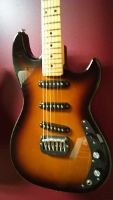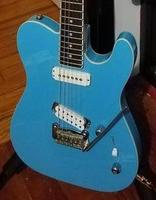9 inch vs 12 inch neck profile
-
Hans Kung+1
- Posts: 6
- Joined: Thu Apr 25, 2019 12:25 am
9 inch vs 12 inch neck profile
After 7 years of buying and selling fender strats and gibons LP because they were uncomfortable to play, I finally found my answer in the tribute bluesboy hb. Because of my Hobbit hands the neck, 1 5/8 wide, med. C and 9 inch neck profile on this guitar is a real joy to play,the pickups aren't my first choice but that's a small price to pay for a comfortable neck and because you can't have to much of a good thing I want more G & L's! The guitars with similar necks are the tribute Fallout and the S-500, the only difference is the 12 inch radius vs the 9 on the blues boy. I was wondering if a 12 inch radius will make playing chords more difficult? Thanks in advance for your feed back. I would love to get at least one more G & L.
-
DanDoulogos

- Posts: 688
- Joined: Tue Dec 20, 2016 9:08 am
- Location: Canada
Re: 9 inch vs 12 inch neck profile
I find larger radii easier for playing chords. Classical guitars almost always have flatter fretboards (larger radii) for this reason.
A larger radius however slightly hinders the bending of notes - which tend to choke out sooner because ..physics. So smaller a smaller radius is better for lead work. I think most of us couldn't tell the difference between a 9 inch or a 7.5 inch neck, unless we generously pepper our noodling with two note bends - in which case we'd notice it. I think a smaller radius "feels" better when your noodling, but worse when you're playing chords.
So I typically go with the middle of the road. If I was going to have a guitar specifically for 'chording' I'd probably want a larger radius for it.
A larger radius however slightly hinders the bending of notes - which tend to choke out sooner because ..physics. So smaller a smaller radius is better for lead work. I think most of us couldn't tell the difference between a 9 inch or a 7.5 inch neck, unless we generously pepper our noodling with two note bends - in which case we'd notice it. I think a smaller radius "feels" better when your noodling, but worse when you're playing chords.
So I typically go with the middle of the road. If I was going to have a guitar specifically for 'chording' I'd probably want a larger radius for it.
G & L: '08 Comanche (Tribute) | '14 ASAT Classic | '00 ASAT Spec | '21 JB2 (Tribute)
Other: '87 Strat | '05 Heritage CH-157 | '12 Tele Select Koa | '19 MJT Esquire | '18 Taylor | 2015 Chrome Epi Dobro |
Other: '87 Strat | '05 Heritage CH-157 | '12 Tele Select Koa | '19 MJT Esquire | '18 Taylor | 2015 Chrome Epi Dobro |
-
Craig

- Site Admin
- Posts: 11556
- Joined: Tue Mar 03, 2009 10:52 am
- Location: Either Coto De Caza, CA or Paso Robles, CA
Re: 9 inch vs 12 inch neck profile
You might also look (and try out) the Tribute ASAT Special as it has the same neck as your bluesboy. Also, the Tribute Doheny has a 9" radius neck, too.Hans Kung+1 wrote: The guitars with similar necks are the tribute Fallout and the S-500, the only difference is the 12 inch radius vs the 9 on the blues boy. I was wondering if a 12 inch radius will make playing chords more difficult? Thanks in advance for your feed back. I would love to get at least one more G & L.
See: January 23, 2019-present Tribute Series Production Models.
Hope this helps.
--Craig [co-webmaster of guitarsbyleo.com, since Oct. 16, 2000]
Welcome! Read This First
Got a G&L question? Check out the: G&L Knowledgebase
Current G&L Specifications and Options
Welcome! Read This First
Got a G&L question? Check out the: G&L Knowledgebase
Current G&L Specifications and Options
-
Hans Kung+1
- Posts: 6
- Joined: Thu Apr 25, 2019 12:25 am
Re: 9 inch vs 12 inch neck profile
Thanks, I'm checking it out now.Craig wrote:You might also look (and try out) the Tribute ASAT Special as it has the same neck as your bluesboy. Also, the Tribute Doheny has a 9" radius neck, too.Hans Kung+1 wrote: The guitars with similar necks are the tribute Fallout and the S-500, the only difference is the 12 inch radius vs the 9 on the blues boy. I was wondering if a 12 inch radius will make playing chords more difficult? Thanks in advance for your feed back. I would love to get at least one more G & L.
See: January 23, 2019-present Tribute Series Production Models.
Hope this helps.
-
Hans Kung+1
- Posts: 6
- Joined: Thu Apr 25, 2019 12:25 am
Re: 9 inch vs 12 inch neck profile
What your saying is the color opposite of what I understand about guitar necks.DanDoulogos wrote:I find larger radii easier for playing chords. Classical guitars almost always have flatter fretboards (larger radii) for this reason.
A larger radius however slightly hinders the bending of notes - which tend to choke out sooner because ..physics. So smaller a smaller radius is better for lead work. I think most of us couldn't tell the difference between a 9 inch or a 7.5 inch neck, unless we generously pepper our noodling with two note bends - in which case we'd notice it. I think a smaller radius "feels" better when your noodling, but worse when you're playing chords.
So I typically go with the middle of the road. If I was going to have a guitar specifically for 'chording' I'd probably want a larger radius for it.
-
WitSok

- Posts: 635
- Joined: Sat Jun 01, 2013 4:49 pm
Re: 9 inch vs 12 inch neck profile
I think Dan was just getting confused as the fist part of his reply speaks of a smaller radius being easier to chord and large radius (flatter) not choking out as quickly when bending. A smaller radius will feel like it has more curvature. To be honest, I find some chords actually easier on flatter fingerboards (E form bar chords as an example).
Perhaps it is because I started on 12 inch radius, I haven't notice much difference in play-ability between 7.5, 9.5, and 12 inch fingerboards. In my opinion fret type make a much bigger difference. I really prefer medium jumbo compare to the short narrow vintage frets. Not a fan of short narrow frets.
Personally, I don't think it would be a big deal. It should be too hard to find some guitars with different radii to try. I like 12 inch best, but haven't tried anything flatter either.
I wouldn't let the fingerboard radius turn you away...
Cheers,
another Dan
Perhaps it is because I started on 12 inch radius, I haven't notice much difference in play-ability between 7.5, 9.5, and 12 inch fingerboards. In my opinion fret type make a much bigger difference. I really prefer medium jumbo compare to the short narrow vintage frets. Not a fan of short narrow frets.
Personally, I don't think it would be a big deal. It should be too hard to find some guitars with different radii to try. I like 12 inch best, but haven't tried anything flatter either.
I wouldn't let the fingerboard radius turn you away...
Cheers,
another Dan
Last edited by WitSok on Tue May 07, 2019 8:45 am, edited 1 time in total.
-
Cactus Jack
- Posts: 103
- Joined: Fri Mar 15, 2019 10:35 am
Re: 9 inch vs 12 inch neck profile
I can't tell the difference between 7.5" and 9.5". Both are equally playable and I'd be hard pressed to tell the difference if you handed one or the other to me. I was always leary of smaller radius guitars, but after playing them for myself my fear was unfounded. It's very easy to tell the difference between 7.5" and 12" as the 12" is visibly flatter. I somewhat prefer the 12" but have zero issues chording or bending on either size.
-
WitSok

- Posts: 635
- Joined: Sat Jun 01, 2013 4:49 pm
Re: 9 inch vs 12 inch neck profile
Yep, that is pretty much my experience.Cactus Jack wrote:I can't tell the difference between 7.5" and 9.5". Both are equally playable and I'd be hard pressed to tell the difference if you handed one or the other to me. I was always leary of smaller radius guitars, but after playing them for myself my fear was unfounded. It's very easy to tell the difference between 7.5" and 12" as the 12" is visibly flatter. I somewhat prefer the 12" but have zero issues chording or bending on either size.
-
Nedmundo
- Posts: 33
- Joined: Tue Nov 24, 2015 6:55 am
Re: 9 inch vs 12 inch neck profile
I'm fairly sensitive to fretboard radius, and have developed a clear preference for flatter fretboards. This is true for basses (my main instrument) and guitars, but it's most important on five string basses with their wider necks, in part because there's less of a "hump" to reach over to access the lower strings. On fives, I want at least a 12" radius, and I'd gladly go with something like 16". On guitars and four string basses, I prefer 12", but all my guitars are actually 9.5", and I'm OK with those. (I expected 12" on my Comanche, but ordered in the midst of their spec change in 2015 and ended up with the new standard 9.5". I was pretty bummed, but it's fantastic anyway.)
I've found I play a little better with flatter fretboards, both for leads and chords, and IME they allow slightly lower action. I know some disagree on that point, but Fender's setup guide does prescribe lower action for flatter fretboards, so I'm not alone!
The traditional view is that smaller (more curved) radii are better for chords, and flatter are better for leads including string bending. That's why "shredder" guitars usually have flatter fretboards.
I've found I play a little better with flatter fretboards, both for leads and chords, and IME they allow slightly lower action. I know some disagree on that point, but Fender's setup guide does prescribe lower action for flatter fretboards, so I'm not alone!
The traditional view is that smaller (more curved) radii are better for chords, and flatter are better for leads including string bending. That's why "shredder" guitars usually have flatter fretboards.
-
Danley

- Posts: 711
- Joined: Wed Aug 12, 2015 9:23 pm
- Location: Orange County, California Republic
Re: 9 inch vs 12 inch neck profile
I could give a huge geometry lesson, but a smaller radius fretboard will never be capable of as low an action as a flatter (or ideally compound) radius fretboard. The reason is you are essentially trying to match a cone shape (the spread of the strings from the nut to the bridge) with a cylinder (neck radius,) and the smaller the cylinder is, the less it behaves like a flat surface where the string spread could more closely conform to the shape of the neck (imagine laying strings in parallel over a piece of pipe - now try splaying them to match different nut and bridge spacing. If you're doing that over an enormous sewer drain pipe, it hardly matters- but if you're doing that over a small plumbing pipe, now you obviously see the need to have higher action on strings toward the edges. In the middle of the neck/pipe the disparity is less profound.) So it's not just bending affected - it's lowest possible action as well.Nedmundo wrote:I've found I play a little better with flatter fretboards, both for leads and chords, and IME they allow slightly lower action. I know some disagree on that point, but Fender's setup guide does prescribe lower action for flatter fretboards, so I'm not alone!
The traditional view is that smaller (more curved) radii are better for chords, and flatter are better for leads including string bending. That's why "shredder" guitars usually have flatter fretboards.
This is also (in part) the reason why it isn't even ideal to have the fretboard radius match the bridge radius. The middle strings will always be capable of lower action, and the effect is more pronounced with smaller radii - so your bridge should always be flatter by some degree than the radius of your neck for the lowest possible setup. In practice? I just say screw it, and set things up where I'm comfortable and no buzz exists, no measurements
-
DanDoulogos

- Posts: 688
- Joined: Tue Dec 20, 2016 9:08 am
- Location: Canada
Re: 9 inch vs 12 inch neck profile
No, you're right, I middle-age-muddled that. I knew in my head how it all worked, but put it all together backwards. Sigh.Hans Kung+1 wrote:What your saying is the color opposite of what I understand about guitar necks.DanDoulogos wrote:I find larger radii easier for playing chords. Classical guitars almost always have flatter fretboards (larger radii) for this reason.
A larger radius however slightly hinders the bending of notes - which tend to choke out sooner because ..physics. So smaller a smaller radius is better for lead work. I think most of us couldn't tell the difference between a 9 inch or a 7.5 inch neck, unless we generously pepper our noodling with two note bends - in which case we'd notice it. I think a smaller radius "feels" better when your noodling, but worse when you're playing chords.
So I typically go with the middle of the road. If I was going to have a guitar specifically for 'chording' I'd probably want a larger radius for it.
G & L: '08 Comanche (Tribute) | '14 ASAT Classic | '00 ASAT Spec | '21 JB2 (Tribute)
Other: '87 Strat | '05 Heritage CH-157 | '12 Tele Select Koa | '19 MJT Esquire | '18 Taylor | 2015 Chrome Epi Dobro |
Other: '87 Strat | '05 Heritage CH-157 | '12 Tele Select Koa | '19 MJT Esquire | '18 Taylor | 2015 Chrome Epi Dobro |
-
notalk
- Posts: 6
- Joined: Wed Sep 30, 2015 2:01 pm
Re: 9 inch vs 12 inch neck profile
When you say "chords", I'm not sure if you mean barre chords? Anyway, for years, Fender and G&L used 7.5" radius fretboards. Gibson used 12"-14". Most acoustics use 12"-16". Except Ovation which used a 10", and was considered the acoustic for people used to playing electrics.
For me, the 7.5" was too round and the 14" was too flat. I never felt comfortable with either the 7.5" or the 12". Now, I find a 9.5" or 10" to be very comfortable. Some people can switch back and forth with no difficulty. Not sure why, but I'm not one of them. Best help I can provide is for you to play as many different radius necks and see how they feel to you.
For me, the 7.5" was too round and the 14" was too flat. I never felt comfortable with either the 7.5" or the 12". Now, I find a 9.5" or 10" to be very comfortable. Some people can switch back and forth with no difficulty. Not sure why, but I'm not one of them. Best help I can provide is for you to play as many different radius necks and see how they feel to you.
-
Danley

- Posts: 711
- Joined: Wed Aug 12, 2015 9:23 pm
- Location: Orange County, California Republic
Re: 9 inch vs 12 inch neck profile
I really don't detect it while I'm playing - maybe because (contrary to all the minutiae I posted above on how to get action super-low) I don't tend to set things much lower than 'average.' I have a Jackson 12" - 16" Soloist, and plenty of ~7" Fenders; they all are equally easy for me to form chords, and I don't run into any trouble soloing on any of them (maybe if I was aiming to show-off on YouTube with the fastest possible BPM I'd pick the Jackson, but real-world doesn't make a difference; or else, a lot of things make a difference to me more than neck radius does as far as playability.)
...That said, if given the choice I'll still go with the larger of two radii; or compound if available.
...That said, if given the choice I'll still go with the larger of two radii; or compound if available.
-
Nedmundo
- Posts: 33
- Joined: Tue Nov 24, 2015 6:55 am
Re: 9 inch vs 12 inch neck profile
Excellent geometry lesson! I've thought about the geometry slightly differently, with flatter radii making it more likely for the string to vibrate parallel to the tangent of the fret where the string is depressed. In the way, the string is less likely to "run into" the frets when it vibrates. Basically, with a flatter board, your plucking/strumming is more "side to side" relative to the frets, while with a curved radius it's closer to "up and down" unless you precisely adjust your plucking/picking angle to compensate. But, like you said, this isn't much of an issue with the strings at the middle of the fretboard. Maybe that's off, but that's how I picture it.Danley wrote: I could give a huge geometry lesson, but a smaller radius fretboard will never be capable of as low an action as a flatter (or ideally compound) radius fretboard. The reason is you are essentially trying to match a cone shape (the spread of the strings from the nut to the bridge) with a cylinder (neck radius,) and the smaller the cylinder is, the less it behaves like a flat surface where the string spread could more closely conform to the shape of the neck (imagine laying strings in parallel over a piece of pipe - now try splaying them to match different nut and bridge spacing. If you're doing that over an enormous sewer drain pipe, it hardly matters- but if you're doing that over a small plumbing pipe, now you obviously see the need to have higher action on strings toward the edges. In the middle of the neck/pipe the disparity is less profound.) So it's not just bending affected - it's lowest possible action as well.
Despite this, over on a popular bass forum, many disagree that a flatter fretboard allows lower action.
-
neutralomen

- Posts: 191
- Joined: Wed Feb 15, 2017 1:34 pm
Re: 9 inch vs 12 inch neck profile
yeah I think the "flatter board-lower action" thing is misleading. I think the "choking out" and "lower action" issues are both contingent on an important qualifier. If your fretting technique isn't really good i.e. not pressing too hard against the board and bending carefully straight along the fret, smaller radii are less forgiving. Your imprecise playing will show in your sound more quickly.
Larger frets and flatter boards allow for more imprecise play before it starts to effect the sound.
On the manufacturing side, I think the low action myth comes from workmanship. Unless the board is perfectly true and the frets perfectly level, you'll get buzz. On smaller radius necks, I imagine the elliptical pattern is more likely to hit the part of the fret that is "inclining" up towards the middle of the board, so if there's a high fret, this problem is exacerbated.
Case in point, I have a new Japanese Strat from the Japanese factory that I imported. Vintage frets, 7/14 radius. I can bend like a step and a half on fret 17 and there is no fretout at all, provided I do my part and mind my fretting technique.
I still prefer flatter boards and medium jumbo frets because I'm not a great player. In my experience, I have just found that these myths about fretout and action aren't inherent to the design of low radius boards. It's a combination of player error and manufacturing error with the fact that flaws in either are more easily pronounced with small frets/small radius.
Larger frets and flatter boards allow for more imprecise play before it starts to effect the sound.
On the manufacturing side, I think the low action myth comes from workmanship. Unless the board is perfectly true and the frets perfectly level, you'll get buzz. On smaller radius necks, I imagine the elliptical pattern is more likely to hit the part of the fret that is "inclining" up towards the middle of the board, so if there's a high fret, this problem is exacerbated.
Case in point, I have a new Japanese Strat from the Japanese factory that I imported. Vintage frets, 7/14 radius. I can bend like a step and a half on fret 17 and there is no fretout at all, provided I do my part and mind my fretting technique.
I still prefer flatter boards and medium jumbo frets because I'm not a great player. In my experience, I have just found that these myths about fretout and action aren't inherent to the design of low radius boards. It's a combination of player error and manufacturing error with the fact that flaws in either are more easily pronounced with small frets/small radius.
-
Danley

- Posts: 711
- Joined: Wed Aug 12, 2015 9:23 pm
- Location: Orange County, California Republic
Re: 9 inch vs 12 inch neck profile
My 7" radius guitars at the moment are a '66 Mustang and an MIJ Jaguar - and my SC3 . I think you came to the same conclusion I did that it really doesn't matter within most practical limits, and you can play just fine and probably have reasonable action (to your preference) on a 7" neck. That said, the easiest I think I can say it is: unless your neck is a perfect compound/cone shape of the appropriate radius at each end, you won't get *ideal* action. You can't turn the cone into a cylinder without compromising the action somewhere; the smaller the cylinder, the more compromised the action is. Again, very minimal real world application, since humans have played 7" radius necks for years and made great music with them.
-
neutralomen

- Posts: 191
- Joined: Wed Feb 15, 2017 1:34 pm
Re: 9 inch vs 12 inch neck profile
Also proper fretting and picking technique are what get the most out of low action anyway. Most rock players are really heavy handed and the guitar was designed for proper fretting technique and a gliding, "brushing" plectrum technique. Even if the neck is dead flat and dead perfect, you need some relief and high action if you're going to bang on it.Danley wrote:My 7" radius guitars at the moment are a '66 Mustang and an MIJ Jaguar - and my SC3 . I think you came to the same conclusion I did that it really doesn't matter within most practical limits, and you can play just fine and probably have reasonable action (to your preference) on a 7" neck. That said, the easiest I think I can say it is: unless your neck is a perfect compound/cone shape of the appropriate radius at each end, you won't get *ideal* action. You can't turn the cone into a cylinder without compromising the action somewhere; the smaller the cylinder, the more compromised the action is. Again, very minimal real world application, since humans have played 7" radius necks for years and made great music with them.